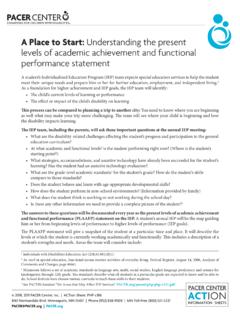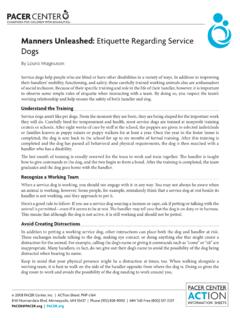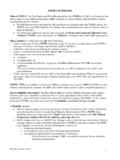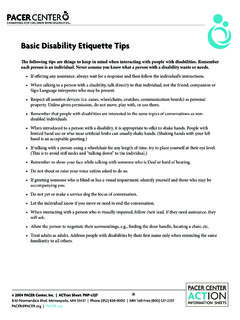Transcription of Crisis Management Plan: Support for Children and Youth ...
1 PACER 2015 Crisis Management plan : Support for Children and Youth with Mental Health Needs at Home Most of us experience a time when events happen that make us feel anxious, distressed, or needing Support . For parents of Children and Youth with mental health needs, an experience that produces distress may quickly escalate into a Crisis if we do not know how to help reduce the intensity of the situation. Parents may also feel embarrassment and shame when caught in a situation they can t stop. Developing a written Crisis Management plan to use at home is one way to be proactive in attempting to handle Crisis situations. A written Crisis Management plan should address positive ways to prevent the escalation of your child or Youth s behavior problems, and identify next steps to take if it does intensify.
2 Remember during interactions with your son or daughter to using as few words as possible, having a neutral facial expression, maintain a calm voice, and a relaxed body posture while using the written plan may also help to stabilize the situation. Who writes the plan ? A Crisis Management plan designed for situations arising at home should be written by the parent with their child or Youth . It can also include information and suggestions from others who know or work with the child and family ( , a family therapist or other mental health provider). It can also be written as part of an individual service plan with the child's mental health provider. The intent of an individualized Crisis Management plan is to decrease the likelihood of escalating behavior problems, provide early intervention and supports, and offer your child help that does not feel threatening.
3 What does a Crisis Management plan include? A Crisis Management plan should include the following key elements: 1. A statement about how your child or Youth looks and acts when he or she is feeling calm and happy. It is important to have a baseline of positive behavior so that you can recognize when your child is not coping well and your Youth s behavior problem is starting to escalate. 2. A list of triggers such as words, gestures, or situations that could increase the behavior problem. A list of triggers should be developed with input from your child or Youth . Consider listing the impact of sudden transitions, noise, medication use or non-compliance, or disrupted sleep. Each child has his or her own level of tolerance, so identifying triggers with your child will give a better picture of what impacts his or her behavior.
4 3. Information about how the child or Youth starts to look when he or she is increasing the unwanted behavior. Some Children have physically observable signs when they are upset like a flushed face, tense body, or tantrums, which can signal loss of control. Older Youth are less likely to demonstrate such obvious signs. For PACER 2015 them, changes in personal hygiene, excessive sleep or sleep deprivation, or changes in social behavior may signal a growing Crisis . One of the most frequent signs of an increasing mental health need may be unprovoked, angry, or disruptive behavior that is out of the ordinary. Describing any observable behavior helps us be proactive. 4. A list of specific actions that have helped calm behavior problems in the past.
5 Identify previous actions that you have taken to help slow down a mounting Crisis . If your child loves hugs, a long hug is likely to make him or her feel loved, signal your understanding, and calm the situation. If, despite the use of an agreed upon strategy, your Youth escalates his or her problem behavior, a time out in a predetermined space for you and your child may calm the situation. 5. Develop a list of specific strategies that your child or Youth says helps prevent a Crisis from occurring, and a corresponding plan of when and how to use the strategies. Over time, your child or Youth has likely given you clues about what helps in regaining his or her self -control. Prearrange a signal for you to use to prompt your child or Youth to use a strategy.
6 Sometimes simply offering the chance to do an alternate activity helps to change the situation from negative to positive. Examples may include taking a walk, or listening to music 6. A list of specific ways others can help and when they should be asked. Sometimes unwanted behavior does not stop even with well-planned interventions in place. When that happens, have a predetermined list of people who can help. A call to the county mobile Crisis team by you or your child or Youth , to the mental health provider working with your family, or to an informed friend or relative may be just what is needed. Make sure you have a clear statement about how they can help. Finally, stay positive and focused on the Crisis plan activities.
7 When a child or Youth with a mental health challenge demonstrates difficult, angry, or escalating behavior, it upset you, too. If a Crisis Management plan can be created ahead of time that is effective, positive, and specific to your child or Youth , the less likely you are to respond with actions that could potentially escalate the situation. Resources Crisis Prevention and Intervention (CPI) Vanderbilt University, Crisis prevention and Management training Mental Health First Aid- NAMI PACER 2015 Sample Crisis Management plan Fill out the following sample plan with your son or daughter to help manage crises at home. Sample Crisis Management plan Name of Son or Daughter Name of Parent(s) Date: 1.
8 What behavior shows that your son or daughter is feeling well? 2. A list of words, gestures, or situations that trigger or increase unwanted behavior. Words Gestures Situations 3. How does your son or daughter show that he or she is upset? Describe the behaviors, actions, and words. Describe the problem behavior as specifically as you can. Include when and where it usually happens. 4. List specific actions you can take in a Crisis situation that have previously helped PACER 2015 when problem behavior is becoming more intense. Actions Situation 5. List the specific strategies that help. Identify a plan to use the strategies. Strategy plan 6. What others can do to help? Name the Person(s) 1.
9 2. 3. 4. Explain how they can help. 1. 2. 3. 4.









